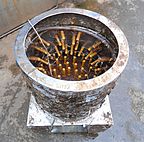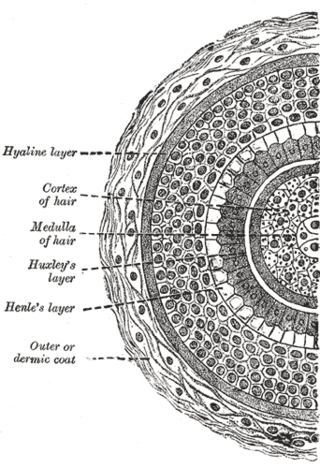
Hair is a protein filament that grows from follicles found in the dermis. Hair is one of the defining characteristics of mammals. The human body, apart from areas of glabrous skin, is covered in follicles which produce thick terminal and fine vellus hair. Most common interest in hair is focused on hair growth, hair types, and hair care, but hair is also an important biomaterial primarily composed of protein, notably alpha-keratin.

Pubic hair is terminal body hair that is found in the genital area of adolescent and adult humans. The hair is located on and around the sex organs and sometimes at the top of the inside of the thighs. In the pubic region around the pubis bone and the mons pubis that covers it, it is known as a pubic patch. Pubic hair is also found on the scrotum and base of the penile shaft in males and on the vulva in females.
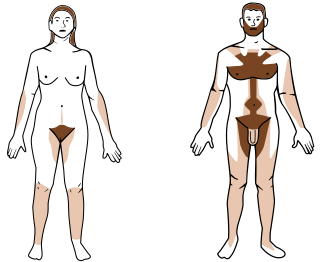
Hair removal, also known as epilation or depilation, is the deliberate removal of body hair or head hair.

Shaving is the removal of hair, by using a razor or any other kind of bladed implement, to slice it down—to the level of the skin or otherwise. Shaving is most commonly practiced by men to remove their facial hair and by women to remove their leg and underarm hair. A man is called clean-shaven if he has had his beard entirely removed.

Waxing is the process of hair removal from the root by using a covering of a sticky substance, such as wax, to adhere to body hair, and then removing this covering and pulling out the hair from the follicle. New hair will not grow back in the previously waxed area for four to six weeks, although some people will start to see regrowth in only a week due to some of their hair being on a different human hair growth cycle. Almost any area of the body can be waxed, including eyebrows, face, pubic hair, legs, arms, back, abdomen, chest, knuckles, and feet. There are many types of waxing suitable for removing unwanted hair.

An eyebrow is an area of short hairs above each eye that follows the shape of the lower margin of the brow ridges of some mammals. In humans, eyebrows serve two main functions: first, communication through facial expression, and second, prevention of sweat, water, and other debris from falling down into the eye socket. It is common for people to modify their eyebrows by means of hair removal and makeup.
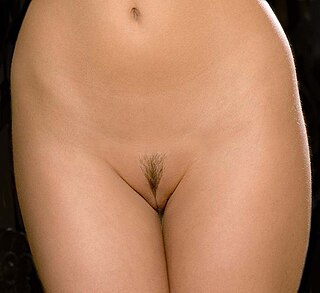
Bikini waxing is the removal of pubic hair using a special wax, which can be hot or cold, that adheres to hairs and pulls them out when the wax is removed quickly from the skin, usually with a cloth strip. While the practice is mainly associated with women, male waxing has become a more common practice to remove men's pubic hair.

Laser hair removal is the process of hair removal by means of exposure to pulses of laser light that destroy the hair follicle. It had been performed experimentally for about twenty years before becoming commercially available in 1995–1996. One of the first published articles describing laser hair removal was authored by the group at Massachusetts General Hospital in 1998. Laser hair removal is widely practiced in clinics, and even in homes using devices designed and priced for consumer self-treatment. Many reviews of laser hair removal methods, safety, and efficacy have been published in the dermatology literature.

Threading is a method of hair removal for both men and women originating in India and Central Asia. It has gained popularity in Western countries, especially with a cosmetic application.

A facelift, technically known as a rhytidectomy, is a type of cosmetic surgery procedure used to give a more youthful facial appearance. There are multiple surgical techniques and exercise routines. Surgery usually involves the removal of excess facial skin, with or without the tightening of underlying tissues, and the redraping of the skin on the patient's face and neck. Exercise routines tone underlying facial muscles without surgery. Surgical facelifts are effectively combined with eyelid surgery (blepharoplasty) and other facial procedures and are typically performed under general anesthesia or deep twilight sleep.

Pseudofolliculitis barbae (PFB) is a type of irritant folliculitis that commonly affects people who have curly or coarse facial hair. It occurs when hair curls back into the skin after shaving, causing inflammation, redness, and bumps. This can lead to ingrown hairs, scarring, and skin discoloration. PFB can be treated with various methods, including changing shaving habits, using topical creams or ointments, and undergoing laser hair removal. Prevention measures include proper shaving techniques, using sharp razors, and avoiding too close a shave.
Sugaring, sugar waxing, or Persian waxing is a method of hair removal that has been in use since 1900 BC. Historically, sugar was confined to the regions surrounding Persia until the first millennium AD. As a result, it is speculated that honey was the first sugaring agent. Sugaring was also known as sukkar or ḥalawa in the Middle East, as ağda in Turkey, and as moum in Iran.

Glochids or glochidia are hair-like spines or short prickles, generally barbed, found on the areoles of cacti in the sub-family Opuntioideae. Cactus glochids easily detach from the plant and lodge in the skin, causing irritation upon contact. The tufts of glochids in the areoles nearly cover the stem surfaces of some cactus species, each tuft containing hundreds of glochids; this may be in addition to, or instead of, the larger, more conspicuous cactus spines, which do not readily detach and are not generally barbed.

In cosmetology, exfoliation is the removal of the surface skin cells and built-up dirt from the skin's surface. The term comes from the Latin word exfoliare. This is a regular practice within the cosmetic industry, both for its outcome of promoting skin regeneration as well as providing a deep cleanse of the skin barrier. Being used in facials, this process can be achieved by mechanical or chemical means, such as microdermabrasion or chemical peels. Exfoliants are advertised as treatments that enhance beauty and promote a youthful and healthy appearance.

Ingrown hair is a condition where a hair curls back or grows sideways into the skin. The condition is most prevalent among people who have coarse or curly hair. It may or may not be accompanied by an infection of the hair follicle (folliculitis) or "razor bumps", which vary in size. While ingrown hair most commonly appears in areas where the skin is shaved or waxed, it can appear anywhere. Anything that causes the hair to be broken off unevenly with a sharp tip can cause ingrown hairs. Ingrown hairs are also caused because of lack of natural exfoliation in the skin.

An epilator is an electrical device used to remove hair by mechanically grasping multiple hairs simultaneously and pulling them out. The way in which epilators pull out hair is similar to waxing, but unlike waxing, they do not remove skin cells. Epilators may use an electric motor or be manually powered with a spring. They may also come with various attachments, like a smaller head to help with epilation of hard-to-reach areas, or an exfoliation head that may help exfoliate the skin before and after epilation.
Body grooming is the act of maintaining a clean appearance. It is typically associated with hair.
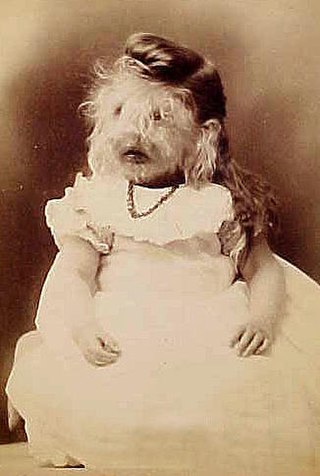
Prepubertal hypertrichosis, also known as childhood hypertrichosis, is a cutaneous condition characterized by increased hair growth, found in otherwise healthy infants and children. Prepubertal hypertrichosis is a cosmetic condition and does not affect any other health aspect. Individuals with this condition may suffer with low self esteem and mental health issues due to societal perceptions of what a "normal" appearance should be. The mechanism of prepubertal hypertrichosis is unclear, but causes may include genetics, systemic illnesses, or medications.

Irritant folliculitis is an inflammation of the hair follicle. It characteristically presents with small red bumps in the skin at sites of occlusion, pressure, friction, or hair removal; typically around the beard area in males, pubic area and lower legs of females, or generally the inner thighs and bottom. An associated itch may or may not be present. Pseudofolliculitis barbae is a type of irritant folliculitis in the beard area.
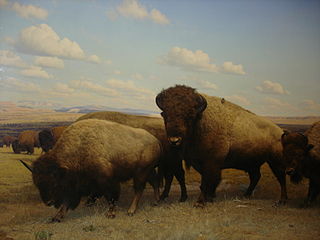
The conservation of taxidermy is the ongoing maintenance and preservation of zoological specimens that have been mounted or stuffed for display and study. Taxidermy specimens contain a variety of organic materials, such as fur, bone, feathers, skin, and wood, as well as inorganic materials, such as burlap, glass, and foam. Due to their composite nature, taxidermy specimens require special care and conservation treatments for the different materials.


